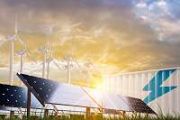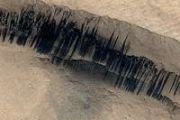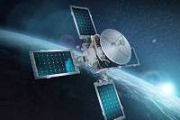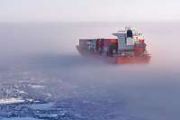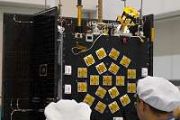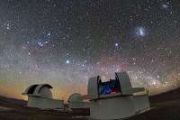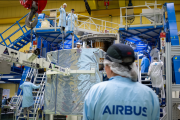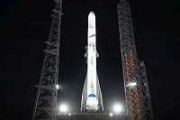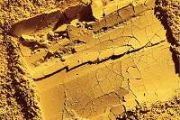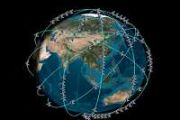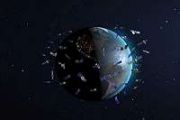
Copernical Team
Airbus Eurostar Neo Arabsat BADR-8 telecoms satellite shipped to launch site
 Airbus' latest next generation geostationary Eurostar Neo satellite Arabsat BADR-8 has been shipped to Cape Canaveral, ready for launch. The satellite will provide connectivity over Europe, Middle East, Africa, and central Asia and also features a world first Airbus' innovative space demonstrator TELEO to provide space to ground optical communicationsc at gigabit speeds.
Airbus' relationsh
Airbus' latest next generation geostationary Eurostar Neo satellite Arabsat BADR-8 has been shipped to Cape Canaveral, ready for launch. The satellite will provide connectivity over Europe, Middle East, Africa, and central Asia and also features a world first Airbus' innovative space demonstrator TELEO to provide space to ground optical communicationsc at gigabit speeds.
Airbus' relationsh Japan okays GPS tracking for bail after Ghosn case
 Japan on Wednesday enacted a law authorising courts to use GPS for tracking defendants on bail, a measure pushed for after the dramatic 2019 escape of former Nissan boss Carlos Ghosn.
The revised criminal proceedings law approved Wednesday will enable courts to order the placement of GPS devices on defendants to prevent them from fleeing Japan.
The defendants will be banned from removin
Japan on Wednesday enacted a law authorising courts to use GPS for tracking defendants on bail, a measure pushed for after the dramatic 2019 escape of former Nissan boss Carlos Ghosn.
The revised criminal proceedings law approved Wednesday will enable courts to order the placement of GPS devices on defendants to prevent them from fleeing Japan.
The defendants will be banned from removin EELS slithers into new robotics terrain
 A versatile robot that would autonomously map, traverse, and explore previously inaccessible destinations is being put to the test at NASA's Jet Propulsion Laboratory.
How do you create a robot that can go places no one has ever seen before - on its own, without real-time human input? A team at NASA's Jet Propulsion Laboratory that's creating a snake-like robot for traversing extreme terra
A versatile robot that would autonomously map, traverse, and explore previously inaccessible destinations is being put to the test at NASA's Jet Propulsion Laboratory.
How do you create a robot that can go places no one has ever seen before - on its own, without real-time human input? A team at NASA's Jet Propulsion Laboratory that's creating a snake-like robot for traversing extreme terra How NASA's work led to commercial spaceflight revolution
 For more than 60 years, NASA has pushed the boundaries of human exploration for the benefit of all, and now the agency's influence and experience are fueling U.S. commercial industry's growth in human spaceflight in low Earth orbit.
In the not-too-distant past, one had to be sponsored by a government to fly to space. Now, fully private crews strap into commercially owned and operated human
For more than 60 years, NASA has pushed the boundaries of human exploration for the benefit of all, and now the agency's influence and experience are fueling U.S. commercial industry's growth in human spaceflight in low Earth orbit.
In the not-too-distant past, one had to be sponsored by a government to fly to space. Now, fully private crews strap into commercially owned and operated human UK gives Viasat clearance to acquire Inmarsat
 Viasat Inc., (NASDAQ: VSAT), a global communications company, and Inmarsat, a leading provider of global mobile satellite communications services, are pleased that the UK's Competition and Markets Authority (CMA) has announced the conclusion of its Phase II review, which confirmed its provisional findings that the transaction does not raise competition concerns, and allows Viasat's proposed acqu
Viasat Inc., (NASDAQ: VSAT), a global communications company, and Inmarsat, a leading provider of global mobile satellite communications services, are pleased that the UK's Competition and Markets Authority (CMA) has announced the conclusion of its Phase II review, which confirmed its provisional findings that the transaction does not raise competition concerns, and allows Viasat's proposed acqu SwRI selected for Phase A study to develop next-generation NOAA coronagraph
 NASA has selected Southwest Research Institute for a Phase A study to develop SwRI's Space Weather Solar Coronagraph (SwSCOR) on behalf of the National Oceanic and Atmospheric Administration (NOAA). NOAA's Space Weather Next Program is charged with providing critical data for its space weather prediction center. SwRI is one of five organizations developing a definition-phase study to produce the
NASA has selected Southwest Research Institute for a Phase A study to develop SwRI's Space Weather Solar Coronagraph (SwSCOR) on behalf of the National Oceanic and Atmospheric Administration (NOAA). NOAA's Space Weather Next Program is charged with providing critical data for its space weather prediction center. SwRI is one of five organizations developing a definition-phase study to produce the Ubajara drill site gets green light: Sols 3823-3824
 Earth planning date: Monday, May 8, 2023.
A lot of preparation goes into assessing a potential drill site on Mars, and the "Ubajara" target got the usual treatment. Over the past several sols, Curiosity has diligently characterized the potential "Ubajara" drill site with activities such as MAHLI and APXS, brushing it with the dust removal tool, and completing a "preload" test.
The preload
Earth planning date: Monday, May 8, 2023.
A lot of preparation goes into assessing a potential drill site on Mars, and the "Ubajara" target got the usual treatment. Over the past several sols, Curiosity has diligently characterized the potential "Ubajara" drill site with activities such as MAHLI and APXS, brushing it with the dust removal tool, and completing a "preload" test.
The preload NASA launches SBIR Ignite Catalyst Program for founders and entrepreneurs
 NASA has launched a new program aimed at helping space entrepreneurs and startups prepare to apply for SBIR Ignite funding. The SBIR Ignite Catalyst Program will provide founders with an opportunity to learn more about the SBIR Ignite program, build their NASA networks and knowledge, and strengthen their startup ecosystem connections.
The program includes two key pillars: a Space Startup E
NASA has launched a new program aimed at helping space entrepreneurs and startups prepare to apply for SBIR Ignite funding. The SBIR Ignite Catalyst Program will provide founders with an opportunity to learn more about the SBIR Ignite program, build their NASA networks and knowledge, and strengthen their startup ecosystem connections.
The program includes two key pillars: a Space Startup E China's cargo craft Tianzhou 6 ready for launch
 China's cargo spacecraft, Tianzhou 6, is ready for launch, according to the Wenchang Spacecraft Launch Site, under the Xichang Satellite Launch Center, in China's southern island province of Hainan.
The launch of Tianzhou 6 will be the first spaceflight since China's space station entered into the application and development stage.
The site has completed all preparations and a final
China's cargo spacecraft, Tianzhou 6, is ready for launch, according to the Wenchang Spacecraft Launch Site, under the Xichang Satellite Launch Center, in China's southern island province of Hainan.
The launch of Tianzhou 6 will be the first spaceflight since China's space station entered into the application and development stage.
The site has completed all preparations and a final Rocket Lab to launch small satellite swarm for NASA
 Rocket Lab USA, Inc. (Nasdaq: RKLB) has signed a deal to launch NASA's Starling mission, a multi-CubeSat mission to test and demonstrate autonomous swarm technologies, as well as automated space traffic management for groups of spacecraft in low-Earth orbit.
The four Starling small satellites have been manifested on an Electron commercial rideshare mission scheduled for lift-off from Rocke
Rocket Lab USA, Inc. (Nasdaq: RKLB) has signed a deal to launch NASA's Starling mission, a multi-CubeSat mission to test and demonstrate autonomous swarm technologies, as well as automated space traffic management for groups of spacecraft in low-Earth orbit.
The four Starling small satellites have been manifested on an Electron commercial rideshare mission scheduled for lift-off from Rocke 









